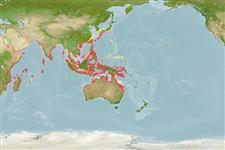Common names from other countries
Environment: milieu / climate zone / depth range / distribution range
Ecologia
Associadas(os) a recifes; intervalo de profundidade 0 - 12 m (Ref. 100949). Tropical
Indo-West Pacific.
Length at first maturity / Tamanho / Peso / Idade
Maturity: Lm ? range ? - ? cm Max length : 8.0 cm SHL macho/indeterminado; (Ref. 349); common length : 6.0 cm SHL macho/indeterminado; (Ref. 349)
Regularly collected for food and shellcraft in many countries of the Indo-West Pacific area (Ref. 349). Among rocks and under stones, in rocky shores. Also found in shallow subtidal depths. Sometimes very common (Ref. 349). Feeds on epilithic algae by grazing (Ref. 85382). Found in intertidal, on rocks (Ref. 75835).
Life cycle and mating behavior
Maturidade | Reprodução | Desova | Ovos | Fecundidade | Larvas
Members of the order Patellogastropoda are mostly gonochoric and broadcast spawners. Life cycle: Embryos develop into planktonic trocophore larvae and later into juvenile veligers before becoming fully grown adults.
Poutiers, J.M. 1998. (Ref. 349)
Status na Lista Vermelha da IUCN (Ref. 130435)
Status no CITES (Ref. 108899)
Not Evaluated
Not Evaluated
Perigo para os humanos
Harmless
Uso pelos humanos
Pescarias: espécies comerciais
| FishSource |
Ferramentas
Mais informação
Idade/Tamanho
Crescimento
Comprimento-peso
Comprimento-comprimento
Morfologia
Larvas
Abundância
Fontes da internet
Estimates based on models
Preferred temperature
(Ref.
115969): 24.8 - 29.3, mean 28.5 (based on 2592 cells).
Vulnerabilidade
Low vulnerability (10 of 100).
